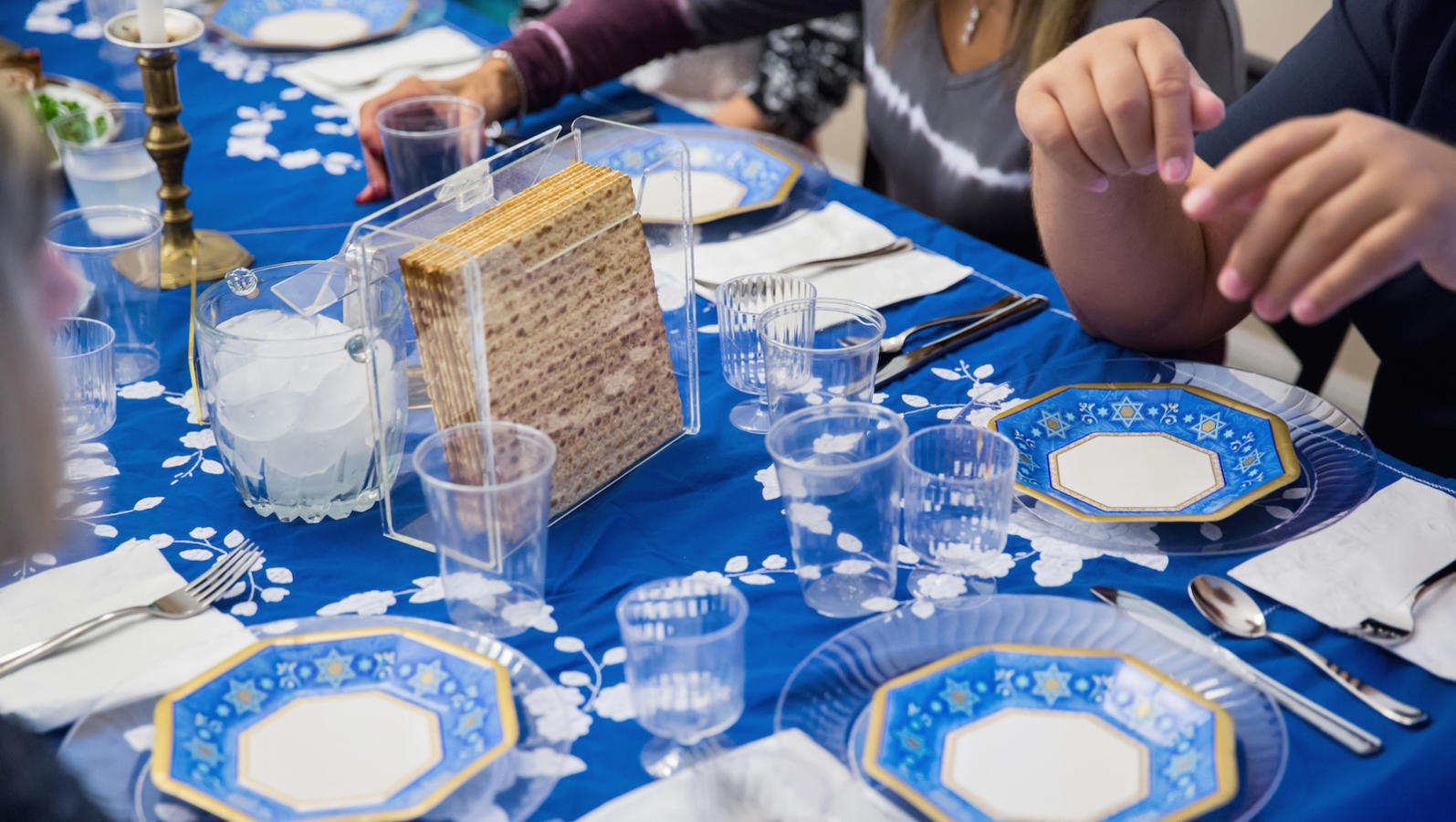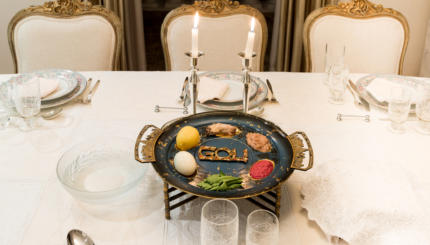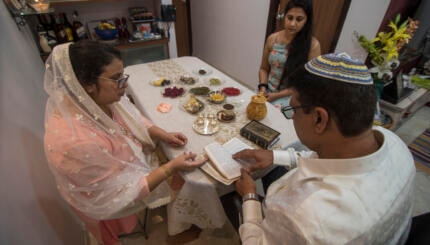This article provides a breakdown of the : each major component and the order in which it traditionally occurs. For more details, including readings, words to the blessings and other materials, you will want to consult a Haggadah.
Note: Before the seder begins, the host traditionally lights the holiday candles and says the blessing.
Barukh atah Eloheynu melekh ha-olam asher kidshanu b’mitzvotav v’tzivanu lehadlik ner shel yom tov.
1. Kadesh — Kiddush
Blessing the wine at the start of the meal. On Friday, the biblical section specific to the Sabbath is added. On Saturday evening, add the section separating sanctity of Sabbath from the sanctity of holy day.

Help us keep Jewish knowledge accessible to millions of people around the world.
Your donation to My Jewish Learning fuels endless journeys of Jewish discovery. With your help, My Jewish Learning can continue to provide nonstop opportunities for learning, connection and growth.
2. Urhatz —Wash
Washing preparation for eating vegetable entree (Karpas). Since the need for such washing was questioned, no blessing is required. It is good to go around to each of the participants, pouring water over the hands from a pitcher into a bowl.
3. Karpas — Spring vegetable
Any vegetable that is not bitter may be eaten. Common vegetables used are celery, parsley, onion, or potato. Dipped in salt water for purification and seasoning they remind us of the vegetation of spring, or the baby boys cast in the Nile, or the tears shed by the slaves. The blessing said is the usual benediction of thanks before eating any vegetable.
4. Yahatz — Divide
Break the middle matzah into two parts. Take larger part, wrap it in napkin and save for the conclusion of the meal. Try — but not too hard — to keep it from being stolen by the children because it must be available for the end of the meal.
5. Magid — Narrate
- Lift up the plate with the symbols of affliction. The traditional invitation to the stranger to join the seder is offered.
- The wine cups are refilled.
- The youngest person at the seder asks the Four Questions.
- The Response to the Questions. Read portions in unison. Have other portions recited by different individuals at the table.
- The Four Sons
- The Ten Plagues. Since our “cup of salvation” cannot be regarded as full when we recall the suffering of the Egyptians, a drop of wine is removed from the cup with the mention of each plague.
- Dayenu (It Would Have Been Enough). Let all present join in the refrain thanking God for all the miracles he bestowed upon the Israelites.
- The cup is again lifted in joy, thankful for God’s deliverance, ready to praise Him with the first word of the Psalm of praise (Hallel).
- Two Psalms of the Hallel.
- Drink the wine, with the blessing of salvation.
6. Rohtza — Wash
Ready to eat, the hands are washed before the meal, as is required at any meal. It is similar to the previous hand-washing, but now all wash with the usual benediction as the hands are dried.
7. Motzi Matzah — Eating Matzah
The first food at the meal is the matzah, the unleavened bread. The usual blessing over bread, Hamotzi, is recited. However, before eating the matzah, a second blessing thanking God for the requirement to eat matzah is recited.
8. Maror — Bitter Herbs
Small pieces of horseradish are dipped into haroset (a sweet paste symbolic of mortar) to indicate that overemphasis on material things results in bitterness. Before eating it, a blessing thanking God for this requirement is recited. Some people mix ground horseradish with charoset.
9. Korekh — Hillel Sandwich
In ancient times, the Talmudic scholar Hillel ate the three symbolic foods (lamb, matzah, and bitter herbs) together so that each mouthful contained all three. Thus the symbols of slavery and liberation were intermingled. Now that we do not have the Paschal lamb, we eat just the matzah and horseradish in a “Hillel sandwich.” No special blessing is said, but we do read the words recalling Hillel’s practice.
10. Shulhan Orekh — Meal
The joyous feasting gives us the feeling of human fellowship in harmony with God.
11. Tzafun — Dessert
Now the afikomen. Either someone has “stolen” it, or parents can hide the afikoman when it is first put aside (Step 4) and let the children look for it during the meal to win a prize.
12. Barekh — Grace After Meals (Birkat Hamazon)
This is the usual “bentschen,” grace after meals, including, of course, thankfulness for the Passover holiday. Fill the cup before this grace and drink the third cup at its conclusion, with the usual “bore p’ri hagafen” blessing.
At this point in the seder, we open the door For Elijah, who by tradition is the forerunner of the Messiah, the harbinger of hope. Sing “Eliyahu Ha-navi.”
13. Hallel — Psalms of Praise
The rest of the evening is given over to hymns and songs. The Hallel is completed, and all join in singing songs: Adir Hu, Had Gadya, etc.
14. Nirtzah — Conclusion
With the traditional formula, the seder is concluded, and the we sing L’Shana HaBa’ah B’Y’rushalayim [Next Year in Jerusalem].
Learn to sing the steps of the seder here:
Prep for Passover like a pro with this special email series. Click here to sign up and you’ll receive a series of helpful, informative, and beautiful emails that will help you get the most out of the holiday.



